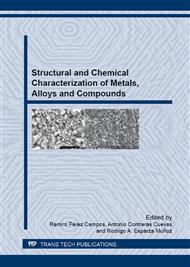[1]
H. Tomaszewski, H. Weglarz, A. Wajler, M. Boniecki, D. Kalinski, Multilayer ceramic composites with high failure resistance, J. Eur. Cer. Soc. 27 (2007) 1373-1377.
DOI: 10.1016/j.jeurceramsoc.2006.04.030
Google Scholar
[2]
R. Bermejo, C. Baudín, R. Moreno, L. Llanes, A. J. Sánchez-Herencia, Processing optimisation and fracture behaviour of layered ceramic composites with highly compressive layers, Comp. Sci. Tech. 67 (2007) 1930-(1938).
DOI: 10.1016/j.compscitech.2006.10.010
Google Scholar
[3]
W. J. Clegg, K. Kendall, N. McN. Alford, T. W. Button and J. D. Birchall, A simple way to make tough ceramics, Nature 347 (1990) 455-456.
DOI: 10.1038/347455a0
Google Scholar
[4]
J. Ma., Hongzhi Wang, Luqian Weng, G.E.B. Tan, Effect of porous interlayers on crack deflection in ceramic laminates, J. Eur. Ceram. Soc. 24 (2004) 825-831.
DOI: 10.1016/s0955-2219(03)00338-8
Google Scholar
[5]
I. Nicolaidis, J. Gurauskis, C. Baudín, R. Moreno and J. Sánchez-Herencia, Forming of ceramic laminates comprising thin layers of a few particles, J. Am. Ceram. Soc. 91 (2008) 2124-2129.
DOI: 10.1111/j.1551-2916.2008.02441.x
Google Scholar
[6]
A. J. Sánchez- Herencia, C. Baudín, Ceramic laminates with tailored residual stresses, Bol. Soc. Esp. Ceram. Vidr. 48 (2009) 311-320.
Google Scholar
[7]
A.J. Sánchez-Herencia, L. M. Llanes Pitarch, C. Baudín, R. Bermejo, Tensiones residuales en cerámicas multicapa de Al2O3-ZrO2: naturaleza, evaluación y consecuencias sobre la integridad estructural, Bol. Soc. Esp. Ceram. Vidr. 45 (2006) 352-357.
DOI: 10.3989/cyv.2006.v45.i5.276
Google Scholar
[8]
N.M. Rendtorff, L. B. Garrido, E. F. Aglietti, Zirconia toughening of mullite–zirconia–zircon composites obtained by direct sintering, Ceram. Int. 36 (2010) 781-788.
DOI: 10.1016/j.ceramint.2009.11.010
Google Scholar
[9]
A. Kaiser, M. Lobert, R. Telle, Thermal stability of zircon (ZrSiO4), J. Eur. Ceram. Soc. 28 (2008) 2199-2211.
DOI: 10.1016/j.jeurceramsoc.2007.12.040
Google Scholar
[10]
C. P. Wong, Rajas S. Bollampally, Thermal conductivity, elastic modulus, and coefficient of thermal expansion of polymer composites filled with ceramic particles for electronic packaging, J. Appl. Pol. Sci. 74 (1999) 3396-3403.
DOI: 10.1002/(sici)1097-4628(19991227)74:14<3396::aid-app13>3.0.co;2-3
Google Scholar
[11]
R. Torrecillas, J. S. Moya, Mecánica de fractura en materiales cerámicos frágiles. I: Principios fundamentales, Bol. Soc. Esp. Ceram. Vidr. 27 (1988) 123-135.
Google Scholar
[12]
S. Bueno, C. Baudín, Mechanical behaviour of structural ceramics, Bol. Soc. Esp. Ceram. Vidr. 46 (2007) 103-118.
DOI: 10.3989/cyv.2007.v46.i3.241
Google Scholar
[13]
T.T. Shih, J. Opoku, Application of fracture mechanics to ceramic materials - A state-of-the-art review, Eng. Fract. Mech. 12 (1979) 479-498.
DOI: 10.1016/0013-7944(79)90091-2
Google Scholar


